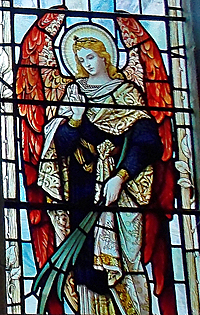
 A general knowledge of the history and locations of churches in Essex can be used to trace family lines. With little effort you can learn to recognize the
difference between an Anglican parish church and a Nonconformist meeting house. Before 1778, Catholic worship was held in private. Some estate homes of wealthy Catholics had private chapels.
A general knowledge of the history and locations of churches in Essex can be used to trace family lines. With little effort you can learn to recognize the
difference between an Anglican parish church and a Nonconformist meeting house. Before 1778, Catholic worship was held in private. Some estate homes of wealthy Catholics had private chapels.
 Most Anglican parish churches were built between 597 and 1530 in three main architectural styles: Saxon, Norman and Gothic. As these styles
predate 1538, when the Church of England was founded, most parish churches were originally built to celebrate the Catholic mass.
Most Anglican parish churches were built between 597 and 1530 in three main architectural styles: Saxon, Norman and Gothic. As these styles
predate 1538, when the Church of England was founded, most parish churches were originally built to celebrate the Catholic mass.
Historically, the Lord of the Manor financed and oversaw the construction of Anglican churches. The style of these buildings can be eclectic. A church with Norman walls and windows, for example, could have Gothic features that were added during repairs or as an upgrade. After 1560, the second wave of Anglican church building did not begin until “the huge rise in population in the 19th century generated an explosion of church building. By 1858, over 3,000 new churches had been built. Several hundred were funded by the public purse. Anxious to counter the rise of non-conformity, in 1818 the government allocated £1,000,000 towards the building and enlargement of Anglican churches throughout England and Wales” (The Church of England – An Introduction. Andrea, Happydaystravelblog, 9 January 2021).
North Aisle Stained Glass Window of St John parish church, Finchingfield, Essex (Photograph by Acabashi, 2015).
 Nonconformist buildings were called chapels or meeting houses. The number of Nonconformist Chapels that were constructed before the 1689 Act of Toleration was limited, but there were some. Catholics built Chapels in their homes and nonconformist used their homes for church meetings. The congregation of the Independent Chapel of Bocking dates to 1672. The Quakers defied authority and built several Meeting Houses. Following the 1689
Act of Tolerance, however, “thousands of places of worship were registered by Nonconformists…During the 18th century, “1,300 new chapels opened…Between 1800 and 1850,
new [Methodist] chapels were opened at the extraordinary rate of almost 250 each year (Nonconformist Places of Worship. Wakeling, Christopher. Edited by Paul Stamper,
Historic England, 2016; Nonconformist Places of Worship is a 24-page pamphlet that is a good primer on Protestantism in England since 1650). After the Act of Toleration
in 1829, Catholics built new buildings using the Gothic Revival style.
Nonconformist buildings were called chapels or meeting houses. The number of Nonconformist Chapels that were constructed before the 1689 Act of Toleration was limited, but there were some. Catholics built Chapels in their homes and nonconformist used their homes for church meetings. The congregation of the Independent Chapel of Bocking dates to 1672. The Quakers defied authority and built several Meeting Houses. Following the 1689
Act of Tolerance, however, “thousands of places of worship were registered by Nonconformists…During the 18th century, “1,300 new chapels opened…Between 1800 and 1850,
new [Methodist] chapels were opened at the extraordinary rate of almost 250 each year (Nonconformist Places of Worship. Wakeling, Christopher. Edited by Paul Stamper,
Historic England, 2016; Nonconformist Places of Worship is a 24-page pamphlet that is a good primer on Protestantism in England since 1650). After the Act of Toleration
in 1829, Catholics built new buildings using the Gothic Revival style.
Laurence Washington, who died in Maldon in 1652, was the twice grandfather of George Washington. Beginning in 1632 Laurence held a pulpit in Purleigh, Essex. During the Civil Wars he was one of more than one hundred priests who lost their benefice on trumped up charges of improper conduct. His only option was to accept a postion as the rector in the improverish parish of Little Braxted. In 1928 the Lord Bishop of Chelmsford dedicated a stained glass window in the All Saints parish church of Maldon to the mememory of Laurence Washington. The window was a gift from the people of Malden, Massachusetts. (Photograph by Monopthalmos, 2018.)
The Architecture of Anglican Churches - The parish church is the iconic silhouette of villages.
The Architecture of Nonconformist Chapels - The percent of noncomformity increases in these parishes.
St Giles of Mountnessing - Barnaby Wood is buried in the churchyard of St Giles.
St Nicholas of Ingrave - St Nicholas was built by Lord Petre, a Catholic.
Thordon Park of Ingrave - The private Catholic Chapel of the Petre family.
United Reformed Church of Little Waltham- Families connect to Wood were congregants.
Colchester Baptist Church- The church were Charles Spurgeon was baptized.
Quaker Meeting House of Maldon - Congregation formed in 1696.
We do not know what you know. Please share with us your knowledge, and help us correct any error you find in our research.